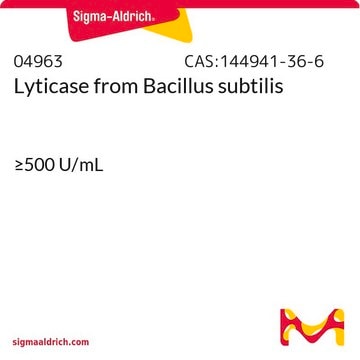The milligram quantity of this product will vary from lot to lot. The vial content is dependent upon the protein content and enzymatic activity. The minimum protein content will be 20% and the minimum activity will be 2000 units per milligram of protein. As an example, a batch that reports a protein content of 20% and an activity of 5000 units per milligram protein will have a vial content of 2 mg for the 10,000 unit package size. The protein content and activity are reported in the product Certificate of Analysis. Please see the link below to review a sample or lot specific Certificate:
https://www.sigmaaldrich.com/product/sigma/l2524#product-documentation
L2524
Lyticase from Arthrobacter luteus
lyophilized powder, ≥2,000 units/mg protein, Protein ≥20 % by biuret
Synonym(s):
(1,3)-β-D-Glucan endohydrolase, 1,3-β-Glucan glucohydrolase, Bacterial lyticase, Lysing enzyme
Select a Size
$101.00
In StockDetails
Select a Size
About This Item
$101.00
In StockDetails
Recommended Products
biological source
bacterial (Arthrobacter luteus)
Quality Level
form
lyophilized powder
specific activity
≥2,000 units/mg protein
composition
Protein, ≥20% biuret
technique(s)
cell based assay: suitable
suitability
suitable for cell lysis
application(s)
diagnostic assay manufacturing
storage temp.
−20°C
Looking for similar products? Visit Product Comparison Guide
Application
- for spheroplasting the cells
- as a component of digestion solution to incubate yeast cells for digestion of the cell wall
- in the enzymatic hydrolysis of the mycelium precipitate to prepare protoplasts
Biochem/physiol Actions
Unit Definition
Physical form
Other Notes
signalword
Danger
hcodes
pcodes
Hazard Classifications
Resp. Sens. 1
Storage Class
11 - Combustible Solids
wgk_germany
WGK 3
flash_point_f
Not applicable
flash_point_c
Not applicable
ppe
Eyeshields, Gloves, type N95 (US)
Choose from one of the most recent versions:
Certificates of Analysis (COA)
Don't see the Right Version?
If you require a particular version, you can look up a specific certificate by the Lot or Batch number.
Already Own This Product?
Find documentation for the products that you have recently purchased in the Document Library.
Customers Also Viewed
Protocols
This procedure may be used for the determination of Lyticase activity using Baker’s yeast as the substrate.
-
How many milligrams is 10,000 units of Product L2524 Lyticase from Arthrobacter luteus?
1 answer-
Helpful?
-
-
Is it purified downstream by affinity chromatography or is it just an ammonium sulfate precipitate?
1 answer-
This product is purified by conventional chromatography following the initial ammonium sulfate precipitation process.
Helpful?
-
-
What is the recommended working concentration of L2524, if a typical 10mg/ml concentration of L1412 is used?
1 answer-
There have been no tests conducted for product L2524 application on the fungus Aspergillus fumigatus. However, according to a citation in Vet Pathol, 2U/100 ul of fungal extraction has shown good results. The citation is titled "Panfungal Polymerase Chain Reaction for Identification of Fungal Pathogens in Formalin-Fixed Animal Tissues" and was published in July 2017. The DOI is 10.1177/0300985817698207, and the PMID is 28346123
Helpful?
-
-
What is the molecular weight of this product?
1 answer-
The molecular weight of Lyticase has not been determined.
Helpful?
-
-
What is the molecular weight of this product?
1 answer-
The molecular weight of Lyticase is not determined.
Helpful?
-
-
I see it is suggested to reconstitute Lyticase fresh. However, if that is not possible, can you store reconstituted Lyticase, L2524, at -20C? If so, for how long?
1 answer-
The solution stability of this product has not been determined. However, according to Cold Spring Harbor Protocols, lyticase may be stored up to 6 months at 4 deg. C when prepared in 10 mM Tris-CL containing 20% glycerol. This has not been validated. See the link below to this citation:
https://cshprotocols.cshlp.org/content/2017/2/pdb.rec090381.full?rss=1Helpful?
-
-
How can Product L2524, Lyticase, be used to make yeast spheroplasts?
1 answer-
The use of lyticase in combination with chitinase and glucuronidase in the preparation of spheroplasts from C. albicans has been described in the following reference: Calvert, C.M., and Sanders, D., "Inositol Trisphosphate-dependent and -independent Ca2+ Mobilization Pathways at the Vacuolar Membrane of Candida albicans". J. Biol. Chem. 270, 7272-7280 (1995).
Helpful?
-
-
How do I solubilize Product L2524, Lyticase?
1 answer-
The quality control enzymatic assay protocol for Lyticase uses cold deionized water to make a solution at 500 units/mL.
Helpful?
-
-
How can I store Product L2524, Lyticase, once reconstituted?
1 answer-
When lyticase is reconstituted and stored, it may be stable for no more than 4-6 hours before serious loss of activity is observed. It is suggested that fresh solutions be prepared for use.
Helpful?
-
-
What is the Department of Transportation shipping information for this product?
1 answer-
Transportation information can be found in Section 14 of the product's (M)SDS.To access the shipping information for this material, use the link on the product detail page for the product.
Helpful?
-
Active Filters
Our team of scientists has experience in all areas of research including Life Science, Material Science, Chemical Synthesis, Chromatography, Analytical and many others.
Contact Technical Service








